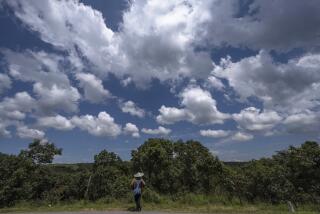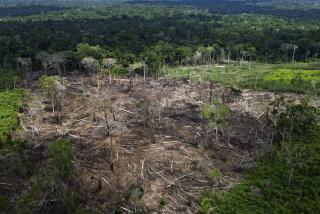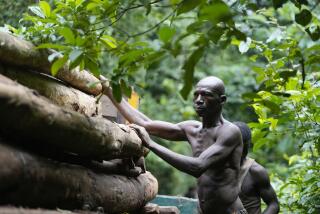Environment : Face-Off Heats Up Over Teak in Asian Forest : As the price of the trees booms, ecologists say that mechanized cutting is rapidly draining key rain forests on the Thai-Myanmar border.
MAE SOT, Thailand â Huge piles of felled teak trees line Thailandâs border with Myanmar, a stark monument both to the new spirit of commercial exploitation between the two countries and to the rapidly diminishing rain forest they share.
The teak logs have been left in depots on the Thai side of the border for transport to sawmills, now that the annual monsoon rains have made quagmires out of the new roads that Thai logging companies have cut into Myanmarâs forests. Like an annual rite of autumn, the logging will resume when the rains halt in October.
Environmentalists worry that the mechanized logging is plundering Myanmarâs forests, which account for about 80% of the teak remaining in the world. Scientists who have studied satellite photos estimated that loggers cut about 350,000 trees during the 1988-89 logging season, nearly double the sustainable level.
The scientists believe that about 1.25 million acres of Myanmar rain forest (about 20%-25% of the trees are teak) were felled in each of the last five years. That represents five times as much logging as took place in 1975-1980.
Because the world supply is shrinking, the price of top-quality teak has shot up to nearly $20,000 a tree.
According to U.N. figures, Burma earned about $200 million last year from its export of about 944,000 tons of teak and other hardwoods. Japan, Denmark, the United States and Italy were the main purchasers.
âAt current rates of extraction, some local groups believe the forests will be logged out in no more than a few years,â the environmental group Greenpeace International said in a statement issued in Washington. âTherefore, the current practice must be considered mining of the trees, not careful harvest of a potentially renewable resource.â
The worldâs largest forests of teak used to exist in India, where British colonialists cut the wood to use as decks in Royal Navy ships. The so-called central province teak was especially prized because it doesnât warp when subjected alternately to wet and dry conditions. But the cutting was so thorough that the former teak forests of India are now desert.
Thailand had the next-largest teak forests, but huge worldwide demand for the wood in furniture-making, coupled with Thailandâs fondness for teak houses and decorations, inspired so much logging that most of the teak had disappeared by 1985. In 1988, Thailand banned logging entirely because of flooding in areas denuded of trees.
âItâs a heart-rending situation,â said Y. S. Rao, regional forestry officer for the U.N.âs Food and Agriculture Organization in Bangkok. âDoes this generation have the right to use up forest which has been there for hundreds of years of accumulation by nature? We need to have some plan for the future so that our children and grandchildren know what teak looks like. Otherwise, they will have to use their imagination, as they do now to conjure up dinosaurs.â
Myanmar, which was formerly known as Burma, has been a source of teak for centuries, but local loggers formerly used a British-devised plan known as the Burma Selection System to ensure that the forests were self-sustaining.
Under this system, only mature trees of about 100 years of age--standing 100 feet tall and measuring more than 7 feet around--would be marked for cutting by removing a strip of bark at chest height. The tree would be left in the forest for three years, cut down with a hand saw and dragged by elephant to a river for transportation to the cities. The earlier âgirdlingâ caused the tree to dry out and float.
In recent years, however, Myanmarâs military rulers have ruined the economy to such an extent that the only available foreign exchange to buy arms for the army has come from selling off the countryâs natural resources, especially wood, fish and gems. In addition, the World Bank actually prodded the authorities to use more economical means of cutting the trees to maximize income.
Logging serves convenient political needs of the military government in Myanmar as well. The teak forests are largely located in areas dominated by restive ethnic minorities, such as the Karens, who have been fighting the central government for independence for more than 40 years. The Karens have used teak logging as an important source of revenue.
By selling more than 40 forest concessions to Thai companies, the government in Myanmar gained a crucial economic benefit from an area outside of its military control, denied income to the insurgents and forced the Thais to limit insurgent activity on the Thai side of the border. The Thai companies are even building roads that make it easier for the Myanmar army to move about the region.
Em Marta, foreign affairs secretary for the Karen National Union, said that the Karens are so desperate financially that they have been forced to take small fees from the Thai loggers in return for their reluctant complicity in the logging.
âWeâre bankrupt, we need the money to survive,â Marta explained. âWeâd rather do it without the destruction of our rain forests. (But) the teak feeds our people.â
âTeak and other tropical timbers are not only being torn from the forests of Burma with no care or regard for the future, they are also being harvested over, literally speaking, the dead bodies of the indigenous Karen and Mon people,â Sen. Daniel Patrick Moynihan (D-N.Y.) told Congress recently, referring to the continuing conflict between the minority population and the government in Yangon (formerly Rangoon). âIt is no hyperbole to say that with every log from the forests comes a dead Burmese minority.â
Moynihan, an outspoken critic of human rights abuses in Myanmar, has proposed legislation banning teak and other imports from the country. Compromise legislation is now being negotiated in conference committee.
Apart from the political implications, environmentalists are most concerned about the logging methods currently being used in the rain forests. Mechanized logging using power saws, tractors and 18-wheel trucks to haul the logs has replaced the quaint old system using girdling and elephants.
Environmentalists maintain that the mechanized method is stripping the forest cover rather than selectively harvesting the mature teak trees. Even though a government inspector is supposed to mark trees mature enough to be cut, undersized trees have been spotted at depots in Thailand marked with the âhammerâ imprint of official approval.
âIt is obvious,â said Greenpeace, âthat the only mangement system currently employed in Myanmar is for Thai companies to cut as many trees as fast as possible. The only government people in the forests are soldiers fighting ethnic groups.â
Of particular concern to scientists is the low rate of replanting taking place in the rain forests--only 50,000 acres a year compared to the 1.25 million being cut down. The Myanmar authorities are also failing to take advantage of the fact that once a teak tree is felled, the stump quickly regenerates with several shoots called âcoppice.â If properly managed, the shoots will grow into full sized trees.
The Myanmar authorities have denied that clear-cutting of the trees is taking place. Lt. Gen. Chit Swe, minister for agriculture and forestry, told a news conference in June that despite allegations of improper logging, satellite photos âclearly show the existence of thick forests in Myanmar.â He said logging was ânot permitted for a long-term but allowed only for a limited period.â
But Asian diplomats believe that even the authorities in Myanmar are having second thoughts about the logging, now that they have been able to survey the damage wrought in the past two years by Thai companies. One diplomat said he thinks the Myanmar government will not renew concessions and might seek to break existing agreements.
More to Read
Sign up for Essential California
The most important California stories and recommendations in your inbox every morning.
You may occasionally receive promotional content from the Los Angeles Times.










